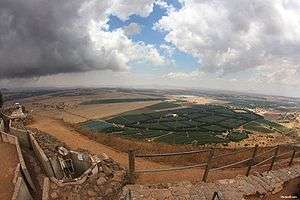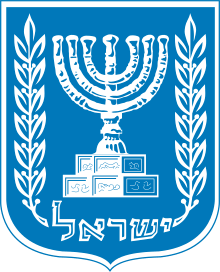Israel–Syria relations
 | |
Israel |
Syria |
|---|---|
Israel–Syria relations refers to bilateral ties between Israel and Syria. The two countries have since the establishment of the State of Israel been in a state of war. The countries have fought three major wars, which are the 1948 Arab Israeli War in 1948, the Six-Day War in 1967, and the Yom Kippur War in 1973, later also being involved in the Lebanese Civil War and the 1982 Lebanon War, as well as the War of Attrition. At other times armistice arrangements have been in place. Efforts have been made from time to time to achieve peace between the neighbouring states, without success.
Syria has never recognised the State of Israel and does not accept Israeli passports for entry into Syria. Israel also has regarded Syria as an enemy state and generally prohibits its citizens from going there. There have not been diplomatic relations between the two countries since the creation of both countries in the mid-20th century.
There have been virtually no economic or cultural ties between the two countries, and a limited movement of people across the border. Syria continues to be an active participant in the Arab boycott of Israel. Both countries do allow a limited trade of apples for the Golan Druze villages, located on both sides of the ceasefire line, and Syria supplies 10% of the water for the town of Majdal Shams, near the Syrian border, as a part of an agreement that has been ongoing since the 80s.[1] The state of peace at the ceasefire line has been strained during the Syrian civil war, which began in 2011 and is ongoing.
History
1948–1975

Since the 1949 Armistice Agreements, relations between Israel and Syria have been characterized by periods of hostility; ceasefire talks, sometimes through intermediaries; and disengagement agreements, such as the 1974 Israeli–Syrian disengagement agreement.
Prior to the 1967 Six-Day War, intermittent hostilities centered on the demilitarized zones, water issues and shelling and infiltration from the Golan Heights. Since the war, the focus of negotiations has been "land for peace," in particular a demand that Israel return the Golan Heights to Syria along with Syrian recognition of Israel and establishment of peaceful relations with it, as stipulated in UN Security Council Resolution 242. And yet, in the US-brokered Syrian–Israeli talks during the 1990s, Syria demanded that Israeli future withdrawal would be to the "June 4, 1967 Lines", namely west of the former British Mandate border with Syria.[2] Syria attempted to recover the Golan Heights in the Yom Kippur War, but was unsuccessful, only recovering a small part of it in the 1974 disengagement agreement, while committing to distance its armed forces further eastwards compared with their 1967–1973 positions.
During Lebanese civil war
In 1982, Israel invaded Lebanon to drive out the PLO. Syria sent ground and air forces to assist the Lebanese, but these were largely routed by the Israelis. Syria continued to support Lebanese militias, leading up to Israel's withdrawal in 2000.
1990s peace efforts
The first high-level public talks aimed at a permanent resolution of the conflict between Israel and Syria were held at and after the multilateral Madrid Conference of 1991. Throughout the 1990s several Israeli governments negotiated with Syria's President Hafez Al-Assad. While serious progress was made, they were unsuccessful.
During Damascus spring: 2000–2005
High points of hostility in the 2000s included the Ain es Saheb airstrike (an Israeli Air Force mission against Palestinian militants inside Syria) in 2003 and Operation Orchard (an Israeli air and commando mission against Syria's alleged nuclear program) in 2007.
Syrian alliance with Iran: 2006–present
During the 2006 Lebanon War, Syria threatened to enter the war on Hezbollah's side, provided support to Hezbollah, and allowed Iran to ship supplies to Hezbollah through its territory. Later, Turkey organized peace talks between the two countries, but Syria later withdrew in response to the 2008–2009 Gaza War.
The September 2007 Operation Orchard attack by the Israeli Air Force destroyed a facility that Israel claimed was a nuclear site in the Deir ez-Zor region.[3][4][5]
In 2010, Syrian President Bashar al-Assad accused Israel of avoiding peace, and Syrian Foreign Minister Walid Muallem warned that in the event of a future war, Israeli cities would be targeted by Syrian missiles. Israeli Foreign Minister Avigdor Lieberman responded by saying that the Syrian military would be defeated in a war with Israel, and Assad and his family would be forced from power. Lieberman also advised Syria to let go of the demand for the Golan Heights.[6] For several months in 2010 Prime Minister Benjamin Netanyahu of Israel engaged in secret, American-brokered discussions with Syria.[7]
During Syrian civil war: 2011–present
Several incidents have taken place on the Israeli–Syrian ceasefire line during the Syrian Civil War, straining the state of peace between the countries. The incidents are considered a spillover of the Quneitra Governorate clashes since 2012 and later incidents between the Syrian Army and the rebels, ongoing on the Syrian-controlled side of the Golan and the Golan Neutral Zone and the Hezbollah involvement in the Syrian Civil War. Through the incidents, which began in late 2012, as of mid-2014, one Israeli civilian was killed and at least 4 soldiers wounded; on the Syrian-controlled side, it is estimated that at least ten soldiers were killed, as well as two unidentified militants, who attempted to penetrate into Israeli-occupied side of the Golan Heights.[8]
On 11 May 2018, Israel urged Syria to reduce the level of Iranian military presence in the country, with Defense Minister Avigdor Lieberman stating: "Throw the Iranians, Qassem Soleimani and the Quds forces out of your country! They are not acting in your interest, they are only hurting you. Their whole presence only brings problems and destruction."[9]
On 10 July 2018, Lieberman did not rule out establishing "some kind of relationship" with Syria under Assad.[10]
On 11 July 2018, Netanyahu stated that Israel was not seeking to take action against Assad, but urged Russia to facilitate the withdrawal of Iranian troops from Syria.[11]
On 2 August 2018, Lieberman stated his belief that Syrian troops regaining control of the country's border with Israel would reduce the chance of conflict in the Golan Heights by providing "a real address, someone responsible, and central rule".[12]
Economic relations
.jpg)
Since 2004, Israel has exported apples to Syria through the Quneitra crossing. In 2010, some 10,000 tons of apples grown by Druze farmers in the Golan Heights were sent to Syria.[13] Israeli minister Ayoub Kara called for an agreement with Syria over the supply of water to towns in the Golan Heights. Today, ten percent of the water in the Druze town of Majdal Shams is supplied by Syria, from the Ein al-Toufah spring. This arrangement has been in place for 25 years.[14]
Tourism and cultural exchange
In 2010, the Israeli government authorized a pilgrimage to Syria by a group of 300 Druze citizens of Israel interested in visiting religious sites there.[15] A group of dancers from five Druze villages in Israel was sent to Aleppo to perform in a dabka competition.[16] Civilians are permitted to cross the border at Quneitra for university studies and marriage. Syrian citizens of the Golan are entitled to free tuition, books and lodging.[17] Since 1993, 67 Syrian brides have crossed into the Golan Heights and 11 brides from Golan have crossed into Syria.[18]
See also
References
- ↑ "Israeli Druze Minister: Syria Should Give Water to Golan Towns".
- ↑ Frederic C. Hof, "Mapping Peace between Syria and Israel", United States Institute of Peace, Washington D.C. 2009
- ↑ IAEA: Syria tried to build nuclear reactor Associated Press Latest Update: 04.28.11, 18:10
- ↑ Beaumont, Peter (16 September 2007). "Was Israeli raid a dry run for attack on Iran?". The Observer/The Guardian. London. Archived from the original on 13 January 2008. Retrieved 16 September 2007.
- ↑ Stephens, Bret (18 September 2007). "Osirak II". The Wall Street Journal. Archived from the original on 7 February 2014. Retrieved 19 September 2007.
- ↑ "FM: If Syria provokes Israel, Assad will be out of power". The Jerusalem Post - JPost.com. Retrieved 17 April 2016.
- ↑ "Secret Israel-Syria Peace Talks Involved Golan Heights Exit". The New York Times. 13 October 2012. Retrieved 17 April 2016.
- ↑ "Israel kills two Syrian gunmen on Golan border". The Times of Israel. Retrieved 30 October 2014.
- ↑ https://www.jpost.com/Middle-East/Liberman-to-Assad-Boot-the-Iranians-out-for-your-own-good-556171
- ↑ "Israel 'not ruling out' eventual ties with Syria's Assad". Reuters. 10 July 2018.
- ↑ "Israel to Russia: Assad's safe from us, but Iran must quit Syria". Reuters. 11 July 2018.
- ↑ "Israel talks up Assad after insurgents killed on Syria frontier". New York Post. 2 August 2018.
- ↑ "Israeli Trucks Cross Into Syria in Annual 'Apple Invasion'". Haaretz.com. Retrieved 17 April 2016.
- ↑ "Israeli Druze Minister: Syria Should Give Water to Golan Towns". Haaretz.com. Retrieved 17 April 2016.
- ↑ "Israeli Druze to go on historic visit to Syria". ynet. Retrieved 17 April 2016.
- ↑ "Hebrew press sees thaw in Syria-Israel relations". Maan News Agency. Retrieved 17 April 2016.
- ↑ Susan Taylor Martin (18 February 2007). "Golan families dream of reunion". Tampa Bay Times. Retrieved 25 October 2008.
- ↑ One way ticket for Druze Syrian Brides Archived 11 April 2009 at the Wayback Machine.
Further reading
- Cobban, Helena (2000). The Israeli-Syrian Peace Talks: 1991-96 And Beyond. Washington, D.C: United States Institute of Peace Press. ISBN 1-878379-98-4.
- Drysdale, Alastair (1991). Syria and the Middle East Peace Process. New York: Council on Foreign Relations Press. ISBN 0-87609-105-2.
- Rabinovich, Itamar (1991). The Road not Taken: Early Arab-Israeli Negotiations. Oxford [Oxfordshire]: Oxford University Press. ISBN 0-19-506066-0.

